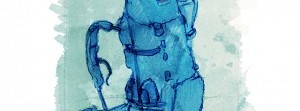
Photo Credit: Dave Quinn
“It’s All About the Caribou” How the Gwaii Haanas Agreement inspired a national park
John “Muffa” Kudlak was born and raised in Paulatuk, NWT, a hamlet of just over 300 residents and one of the most northerly permanent settlements on the Canadian mainland.
He grew up on the land, enjoying all the reasons Paulatuk is a great place to live. Arctic char return every summer to the Hornaday, Brock and Horton rivers. Beluga and polar bear frequent the coastal region. Most importantly, the Bluenose-West caribou herd returns every summer on its annual migration from treeline back to the barren arctic coastal highlands near town to have their calves.
Kudlak’s life as a hunter and an Arctic guide-outfitter changed when a ban on international trade in sea mammals made it impossible for him to find clients. More recently, drastic declines in caribou numbers have halted all trophy hunting of caribou. It was clear to Kudlak that Paulatuk needed a new economy—a solution that protected the interests of multiple stakeholders while protecting the environment and allowing locals to continue practising their culture on the land.
In the 1990s, Kudlak got involved in the land claims settlement process for the Inuvialuit Settlement Region. A sprawling 90,650 square kilometres, the region contains some of the most extensive, pristine wilderness left on the planet as well as some of the most coveted natural resources: diamonds and oil in abundance.
One of the settlement process’s goals was to clarify the rights of access for resource extraction companies. Diamonds, gold and oil all called to hungry investors. The Inuvialuit aimed to balance economic development of the north for northerners with permanent protection of lands deemed critical to their culture and way of life.
To this end they proposed three protected areas as part of the Inuvialuit land claims settlement: Aulavik National Park to protect the rich migratory bird habitat of the Thomsen River Valley on Banks Island, Ivvavik National Park on the Yukon-Alaska border to protect the calving grounds of the Porcupine Caribou Herd and Tuktut Nogait National Park, to protect the calving grounds of the Bluenose-West caribou herd.
From caribou to salmon
The people of Paulatuk liked the co-management model pioneered by the Haida with the groundbreaking 1993 Gwaii Haanas Agreement. This unique model required neither the federal government nor the Haida Nation to officially cede their respective title claims and interests on the land inside the park reserve boundaries, but instead allowed them to move forward with their shared interest in protecting the landscape. Traditional Haida activities were allowed to continue and both parties share management decisions.
To better understand the Gwaii Haanas Agreement, a team from Paulatuk travelled south to learn firsthand from the Haida. It was a long journey: 19-passenger Twin Otter to Inuvik, jet to Yellowknife, Edmonton, Vancouver and, finally, back north to Sandspit. Kudlak came south representing the Paulatuk Hunters and Trappers Committee.
“I remember that trip like it was yesterday!” he recalls with a grin that lights up the tundra. “The Haida people were our hosts. I ate so much salmon I could barely walk! They also eat seaweed. We have seaweed here too, but we never eat it! The size of the trees is what impressed us the most, and the canoes and poles and houses they made out of them. We have nothing like that up here.”
The Inuvialuit wanted Parks to protect caribou calving areas while ensuring residents could continue to live off the land, with any benefits from the park remaining in Paulatuk: “The Gwaii Haanas co-management model lets everyone into the room, to make decisions that are best for the land and best for the people that are a part of that land,” Kudlak says.
Like the Haida, the Inuvialuit are inseparable from their traditional lands. Without salmon, sg_luu (purple laver), kaaw (herring roe on kelp) and a healthy ocean, the Haida culture loses much of its essence. Without caribou, char, lake trout, muskox and time out “on the land,” much of what the Inuvialuit have become over thousands of years would be greatly diminished.
“When we are at home the satellite dish comes on, the furnace fires up and we are all stuck to our little cellphones,” Kudlak explains. “Come the weekend, we have to disconnect and get back onto the land. We cannot live away from the land. Out here is where we are alive.”
With help from the Haida, the Inuvialuit of Paulatuk pursued co-management of Tuktut Nogait National Park. After six years of negotiations, an agreement between the federal government, Northwest Territories, Inuvialuit Regional Corporation, Inuvialuit Game Council, Paulatuk Community Corporation and Paulatuk Hunters and Trappers Committee was signed in June 1996, protecting over 16,000 square kilometres just south of town. The park contains 360 archeological sites, as well as numerous large tundra lakes full of leg-sized lake trout and sea-run arctic char. Hornaday River’s canyons and waterfalls are one of the wonders of the north.
Most importantly, it protects the calving grounds of the Bluenose-West. This herd was estimated at 112,000 animals in 1992, but has, like most other caribou herds across Canada, been in freefall ever since. The 2015 estimate pegs the herd at a mere 15,000 animals, just over 10 percent of historical numbers. Climate change, industrial activity and overhunting are all to blame. Spring green-up arrives up to three weeks earlier than normal and the caribou migrations arrive too late to make the most of the best nutrients, a timing that is critical for successful calving and lactating.
Protection of the calving grounds and protection from overhunting is also a critical part of managing the herd’s future. Sixteen communities rely on these caribou as they follow their extensive migration routes, so the potential for over-harvest is real. There has already been a switch to reindeer meat from the large herd near Inuvik and to muskox from Banks Island where a harvest of up to 3,000 animals is allowed.
“It’s all about the caribou,” Kudlak states. For him, the park offers insight into his past, as well as a rare opportunity to earn some income while sharing his wisdom with visitors.
“We try to not even have aircraft fly over the park while the caribou are calving and while the calves are small in May and June,” he explains. “People are welcome to hike anytime, but all our fly-in trips or research that needs helicopter or plane support is planned for August after the caribou begin to move south.”
The last three known Dawson caribou on Haida Gwaii were shot in 1908 as specimens for the Royal British Columbia Museum. While the Haida did not rely significantly on caribou for sustenance, caribou meat is critical for Inuvialuit to feed their families. In a community where a litre of milk or a brown head of broccoli (when it is available) sets you back $10 and a B-grade Christmas turkey can cost over $200, the economics of harvesting healthy, local food weighs nearly as heavy as the cultural connections that this harvest provides.
Conservation and co-operation
Canada’s parliament officially finalized the Tuktut Nogait protection agreement in 1998 and additions to the park from the neighbouring Sahtu Settlement Region added a further 1,850 square kilometres, bringing Tuktut Nogait to 18,000 square kilometres, just shy of the size of the entire Skeena-Queen Charlotte Regional District at 19,700 square kilometres.
Today, Tuktut Nogait is Canada’s second co-managed park. The model is gaining traction throughout the national parks system and around the world. The Déline First Nation entered into Canada’s third protected area co-management agreement with the 2009 creation of Saoyú-ʔehdacho National Historic Site, which protects over 5,500 square kilometres on the Northwest Territories’ Great Bear Lake. Déline First Nation consulted with Tuktuk Nogait’s management board members during the negotiations to protect Saoyú-ʔehdacho and it is hoped that this model will trickle out to many protected areas across Canada.
After Gwaii Haanas, Tuktut Nogait was the first in what is hoped to be a long list of Canadian protected areas that are co-managed by the federal government and local First Nations based on the model created in Haida Gwaii. Co-management is a made-in-the-northwest solution to some of the modern conservation and cultural challenges of the 21st century.
The best way to visit one of Canada’s most remote and least visited national parks is via the Parks Canada Basecamp experience.
Visit www.pc.gc.ca/eng/pn-np/nt/tuktutnogait/ne/camp.aspx for details.






